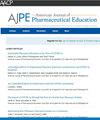Influence of Demographic Characteristics on Perceptions of Pharmacy Faculty Workload Equity: A Post Hoc Analysis
IF 3.5
4区 教育学
Q1 EDUCATION, SCIENTIFIC DISCIPLINES
引用次数: 0
Abstract
Objective
To examine how specific demographic factors affect pharmacy faculty perceptions of workload equity.
Methods
A post hoc analysis of previously published survey results was conducted. Faculty were asked about the comparison of actual vs assigned workload, fairness of assigned workload, domains used by primary decision maker(s) when assigning workload, and the importance of factors to improve perceived fairness. Responses were grouped by gender identity (female vs nonfemale), race and ethnicity (White vs non-White), and clinical practice status (clinical vs nonclinical).
Results
A total of 662 complete responses were received (15.9% response rate). The distribution of effort for research/scholarship differed significantly between females and nonfemales (14.8% vs 22.2%, respectively). Female respondents reported significantly lower alignment between actual and assigned workload and indicated performing more actual service than assigned, compared to nonfemale respondents. This misalignment was also observed among non-White faculty. White faculty were more likely to believe that those assigning workload considered individual context and contributions. Differences were also found in workload allocation across gender identity, race and ethnicity, and clinical practice status, with the most substantial variations in time dedicated to research/scholarship vs clinical practice.
Conclusion
Faculty self-reported workload allocation/assignment and perceptions of actual vs assigned workload varied based on gender identity, race and ethnicity, and clinical practice status. These findings highlight the importance of clear, transparent workload policies and equitable assignment of responsibilities. Considering individual faculty roles and contributions to the overall program is crucial for improving perceived fairness and job satisfaction.
人口统计学特征对药学教师工作量公平观念的影响:事后分析。
目的:研究特定的人口统计学因素如何影响药学教师对工作量公平的看法。方法:对先前公布的调查结果进行事后分析。教师被问及实际工作量与分配工作量的比较,分配工作量的公平性,主要决策者在分配工作量时使用的领域,以及提高感知公平性的因素的重要性。根据性别认同(女性vs.非女性)、种族和民族(白人vs.非白人)和临床实践状况(临床vs.非临床)进行分组。结果:共获得完整应答662份,应答率15.9%。女性和非女性在研究/奖学金方面的努力分配显著不同(分别为14.8%和22.2%)。与非女性受访者相比,女性受访者表示实际工作量与分配工作量的一致性明显较低,并且执行的实际服务比分配的更多。这种偏差在非白人教师中也存在。白人教师更有可能相信,那些分配工作量的人会考虑个人背景和贡献。在性别认同、种族和民族以及临床实践状态的工作量分配方面也存在差异,其中用于研究/奖学金与临床实践的时间差异最大。结论:教师自我报告的工作量分配/分配以及对实际工作量与分配工作量的感知因性别认同、种族和民族以及临床实践状况而异。这些调查结果突出了明确、透明的工作量政策和公平分配责任的重要性。考虑每个教师的角色和对整个项目的贡献对于提高公平感和工作满意度至关重要。
本文章由计算机程序翻译,如有差异,请以英文原文为准。
求助全文
约1分钟内获得全文
求助全文
来源期刊
CiteScore
4.30
自引率
15.20%
发文量
114
期刊介绍:
The Journal accepts unsolicited manuscripts that have not been published and are not under consideration for publication elsewhere. The Journal only considers material related to pharmaceutical education for publication. Authors must prepare manuscripts to conform to the Journal style (Author Instructions). All manuscripts are subject to peer review and approval by the editor prior to acceptance for publication. Reviewers are assigned by the editor with the advice of the editorial board as needed. Manuscripts are submitted and processed online (Submit a Manuscript) using Editorial Manager, an online manuscript tracking system that facilitates communication between the editorial office, editor, associate editors, reviewers, and authors.
After a manuscript is accepted, it is scheduled for publication in an upcoming issue of the Journal. All manuscripts are formatted and copyedited, and returned to the author for review and approval of the changes. Approximately 2 weeks prior to publication, the author receives an electronic proof of the article for final review and approval. Authors are not assessed page charges for publication.

 求助内容:
求助内容: 应助结果提醒方式:
应助结果提醒方式:


